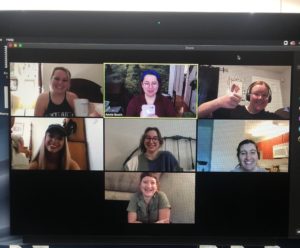Remote Internships with Annie
Annie Booth is the Program Coordinator at MoFA. When the Museum closed to the public in March, she transitioned MoFA’s internship program to remote instruction.
As MoFA’s Program Coordinator I have many roles, including planning and facilitating our internship program. The Museum has three cohorts of interns each year, aligning with the Fall, Spring and Summer semesters. About halfway through the Spring semester, the Museum closed to the public due to COVID-19 and I transitioned our internship program from in-person to remote for the foreseeable future. Conducting remote internships was a completely new experience for many professionals across the sector, myself included. Within a matter of days we were tackling this unique challenge and swiftly becoming Zoom experts. Although my experience is continuously evolving, I would like to share a few tips I have picked up along the way.

Navigating Zoom.
Practice flexibility. We are in an unprecedented time and it is so important to show empathy and flexibility with coworkers and students. Interns may not always have control over their internet or computer access; things may pop-up unexpectedly and schedules may radically change throughout the internship. My coworker aptly used the phrase radical flexibility to describe what’s needed in this moment and I wholeheartedly agree.
Schedule check-ins. I think communication is key to any successful internship. With remote internships, you have to be far more intentional to ensure there are open channels of communication. I have found it helpful to have one-on-one meetings on a weekly basis. By scheduling a dedicated time to meet, you can help fill the gap previously filled by impromptu in-person communication. During these conversations you can discuss how things are going and it presents a great opportunity to get to know each student better.
Ask for feedback. Each student is experiencing a different set of circumstances and as a result, they may benefit from varying communication styles or project timelines. In my experience, the best way to move forward is to communicate with each student individually and discuss what works for them moving forward. Sometimes you need to adjust or reevaluate a project to fit a specific circumstance and that is okay. It can be empowering to invite your students to participate in the planning of their internship and it creates an opportunity for shared ownership of the experience.
Be creative. While some parts of experiences, like art handling, cannot be replicated remotely, with a bit of creativity you can reimagine many aspects of an in-person internship to incorporate into your remote plan. For example, in the Spring semester six interns were working on a culminating tour of our exhibition, Rising Water. While originally, the plan was to promote the tours as free public events, we had to shift our outcome to a Zoom presentation. I think the most successful aspect of this transition was that the skill of writing, editing, and presenting a tour was preserved even though the physical experience did not occur. Another example comes from the current semester, I was tasked with ensuring that a student we would not meet in person would still feel like a part of the MoFA Team. We achieved this by opening up our weekly meetings to our current intern, Elias. It has been a great way for Elias to observe and participate in the conversations and the decision making process. This has been so successful that I hope to carry this aspect of the internship into future semesters.
Below, I asked two students to share a bit about their remote internship experience with you. It is a true privilege to work with students from all different areas of study. I am so grateful for their enthusiasm and resilience as we shift our many plans and expectations.
“It is a very strange experience, but I do not think it is any less informative than if I were to be physically in the space. Because my skills lie in research and archival spaces, the switch to remote is not as tough because I can still do most of my research online. The hardest part is being organized while you are still at home. At times, it just gets tough to look at your computer for 2-4 hours working on just one project, so I do ask for a lot of options when it comes to projects so I can break the time up a bit. Because my internships are at my home, I also have to balance everything in terms of reasonability, while at the same time trying to find time for me.” – Elias Larralde (Summer 2020)
“Transitioning was difficult at times. Though I think the team at the museum communicated well, I think just the nature of communicating through email instead of being able to walk over and talk with someone, made it a little harder. I think though the hardest part was not being able to help the museum in ways directly involving hands-on work with the collections. One of the best things to happen with the transition was that I was able to work on a different schedule that worked better for me. I’m a night owl so I was able to do my tasks and work in the evenings or nights when I was more productive and motivated, which isn’t possible when the museum closes for the night.” – Catherine Alameddin (Spring 2020)